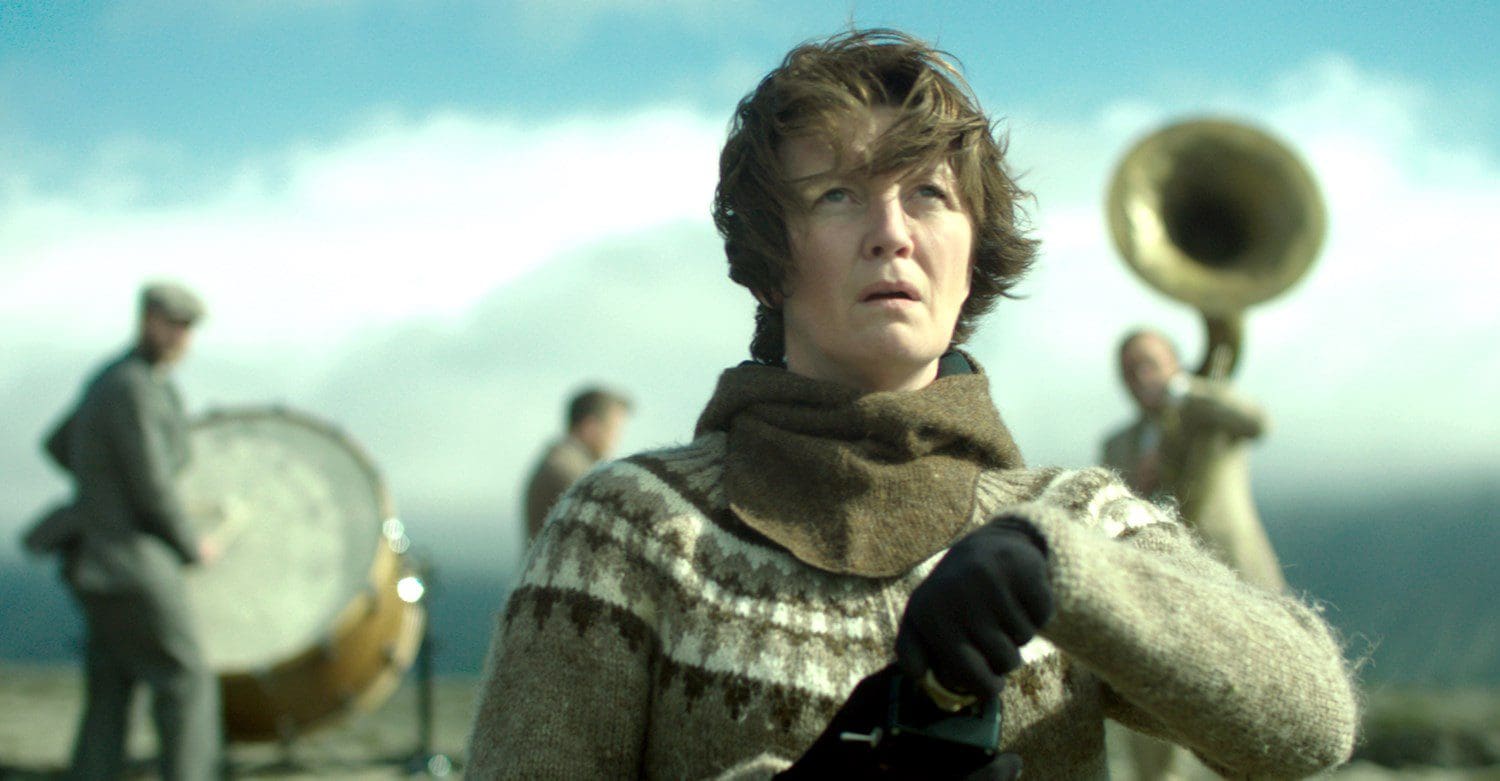
It’s not easy to get an audience to root for a terrorist. Yet that’s exactly what Icelandic filmmaker Benedikt Erlingsson has done with his new film, Woman at War. If follows Halla (Halldóra Geirharðsdóttir), a choir director who we first meet damaging the power lines to a factory. It turns out, this incident is just the latest in her crusade to dismantle the country’s more environmentally-damaging industries and after four years, she and her sole confidant have almost reached their endgame. So, it’s a problem, then, when an adoption agency contacts Halla to say that they want her to foster a young, Ukrainian girl named Nika (Margaryta Hilska). It seems like an outlandish premise and there are moments when it is, but it’s precisely that mix of reality and fantasy that makes Erlingsson’s film so compelling.
Erlingsson has said he views Halla as a sort of Artemis-type character and, indeed, some of the film’s more fantastic moments make it feel like a modern myth. The first is the way he uses music. When we first hear it, the score is somewhat goofy, clearly marking the film as a comedy or at least a farce despite its serious subject matter. Things become even more heightened, though, when the band (made up of a piano, sousaphone and drums) appear in the background of a shot, with Halla stowing her things in the foreground. Though Halla initially ignores the musicians, she eventually interacts with them. In once scene, as Halla tries to ignore the way government officials are using the media to spin her public manifesto, one band member turns the volume up on her TV or turns it back on when she shuts it off until Halla suddenly turns and gives him a menacing look. There and elsewhere, they act as a physical manifestation of her emotional state and–especially when the Ukrainian folk singers appear anytime Nika is mentioned–they act almost like a Greek chorus.
However, even with the chorus, perhaps the most fantastical element in Woman at War is the storytelling itself. Though what happens is rendered fairly realistically, there are moments in Halla’s quest to save the environment when it seems the gods must be smiling upon her. When she runs from the authorities in the film’s opening minutes, she gets help from a sheep farmer—someone who not only shares a connection with the land, but may even be a distant relative. Later, on yet another run from the authorities, nature seems to provide everything she needs to escape just as she needs it. When a heat-seeking camera almost exposes her, nature provides a dead sheep to hide under. When bloodhounds start to approach, it provides a river to mask her scent. In a more grounded film, those moments would seem too convenient, but it’s easy to dismiss them here as either coincidence or Halla loving the land so much that she can use it to her advantage.
Given those fantastic elements, it’s somewhat surprising, then, that the film’s meaning ultimately comes from its more realistic aspect: Halla’s attempt to adopt a child. Though the fact that Halla has spent the 4 years since learning she wouldn’t be allowed to adopt a baby at first seems like a problematic metaphor about the necessity of motherhood, it’s really just an extension of her environmental activism. Nika is an orphan of conflict in Ukraine, a damaged and defenseless thing victimized by the actions of destructive adults. Both Nika and the environment are innocent and beautiful in Halla’s eyes and it’s no coincidence that the sole picture Halla receives of Nika from the adoption agency shows her holding flowers. She is just as much a symbol of what Halla fights for as the icy wilderness she roams and if Erlingsson’s storytelling were any less fantastic or Geirharðsdóttir‘s performance less sympathetic, it might be harder to root for Halla and Nika to meet.
Indeed, it’s Geirharðsdóttir’s quiet, humane performance(s) that makes the whole movie work. As Halla, she shows little of the moral conflict you’d expect from a character whose life is so full of contradictions. She feels justified in what she does because she does it from a pure place of wanting to preserve the world for future generations. The same goes for her desire to raise Nika.
Geirharðsdóttir is just as convincing playing Halla’s twin sister, Ása, a deeply spiritual person who unknowingly disagrees with her sister’s methods as an eco-terrorist. As the former, we buy that she would be clever enough to fool police into not discovering the stolen Semtex in her trunk and as the latter, we buy that she would want to detach from her life and go to India to meditate for two years. Even when the characters appear onscreen together through movie magic, each feels distinct and the whole film is a testament to how much pathos Geirharðsdóttir‘s performances bring to it.
Humanity and possibly planet earth itself are on the brink of extinction and where someone like Paul Schraeder dealt with that prospect through the bleak, possibly nihilistic First Reformed, Erlingsson’s Woman at War is equal parts hopeful and desperate. Halla’s eco-terrorism may only have so much impact against an uncaring government that can distort her message through the media, but she has a little girl waiting for her in Ukraine. She may criticize Ása for thinking personal change can have wider impact, but sometimes that’s the only thing that can keep you going in the face of destruction.
Rating: 8.5/10
A Woman at War opens in select theaters on March 1st.

